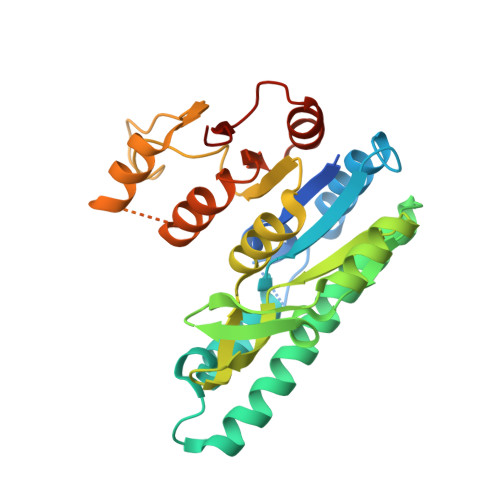Ternary complexes of isopentenyl phosphate kinase from Thermococcus paralvinellae reveal molecular determinants of non-natural substrate specificity.
Johnson, B.P., Mandal, P.S., Brown, S.M., Thomas, L.M., Singh, S.(2024) Proteins 92: 808-818
- PubMed: 38333996
- DOI: https://doi.org/10.1002/prot.26674
- Primary Citation of Related Structures:
8U0K, 8U0L, 8U0M, 8U0N - PubMed Abstract:
Isopentenyl phosphate kinases (IPKs) have recently garnered attention for their central role in biocatalytic "isoprenol pathways," which seek to reduce the synthesis of the isoprenoid precursors to two enzymatic steps. Furthermore, the natural promiscuity of IPKs toward non-natural alkyl-monophosphates (alkyl-Ps) as substrates has hinted at the isoprenol pathways' potential to access novel isoprenoids with potentially useful activities. However, only a handful of IPK crystal structures have been solved to date, and even fewer of these contain non-natural substrates bound in the active site. The current study sought to elucidate additional ternary complexes bound to non-natural substrates using the IPK homolog from Thermococcus paralvinellae (TcpIPK). Four such structures were solved, each bound to a different non-natural alkyl-P and the phosphoryl donor substrate/product adenosine triphosphate (ATP)/adenosine diphosphate (ADP). As expected, the quaternary, tertiary, and secondary structures of TcpIPK closely resembled those of IPKs published previously, and kinetic analysis of a novel alkyl-P substrate highlighted the potentially dramatic effects of altering the core scaffold of the natural substrate. Even more interesting, though, was the discovery of a trend correlating the position of two α helices in the active site with the magnitude of an IPK homolog's reaction rate for the natural reaction. Overall, the current structures of TcpIPK highlight the importance of continued structural analysis of the IPKs to better understand and optimize their activity with both natural and non-natural substrates.
- Department of Chemistry and Biochemistry, University of Oklahoma, Norman, Oklahoma, USA.
Organizational Affiliation:


















